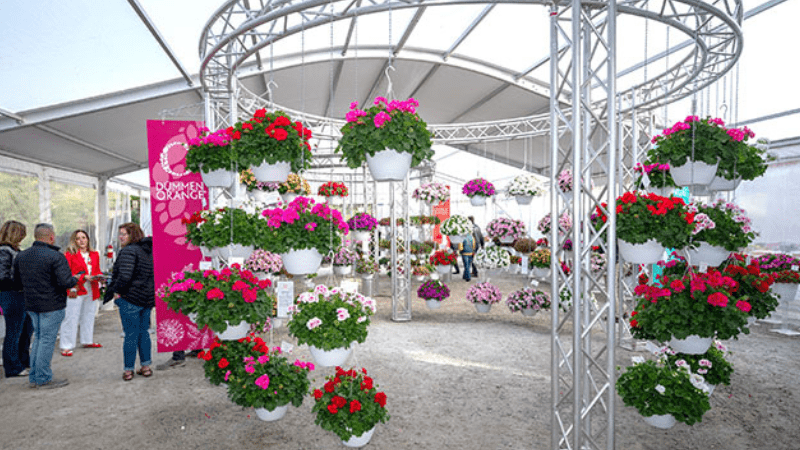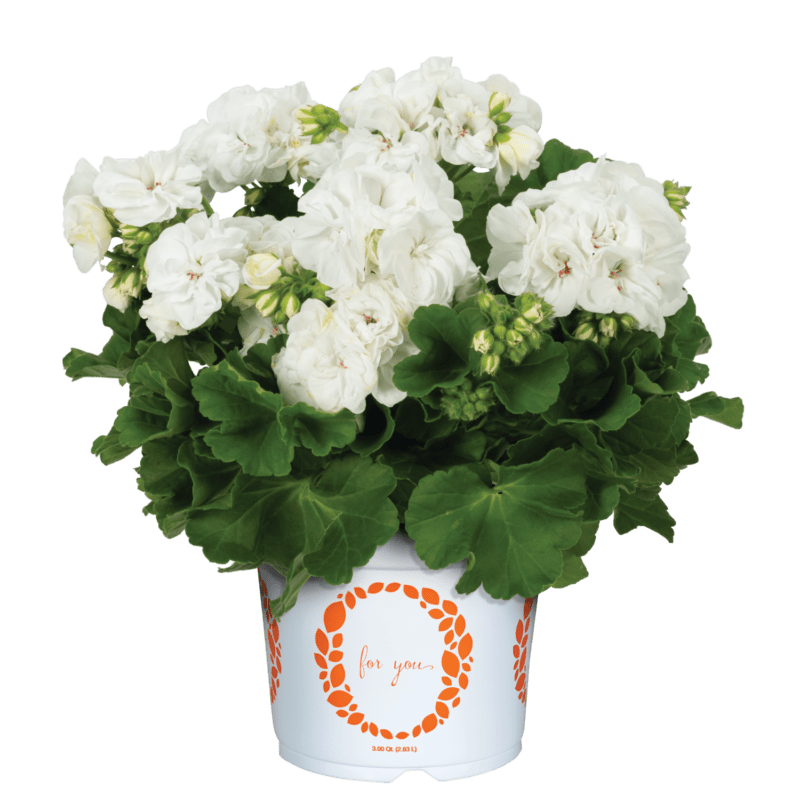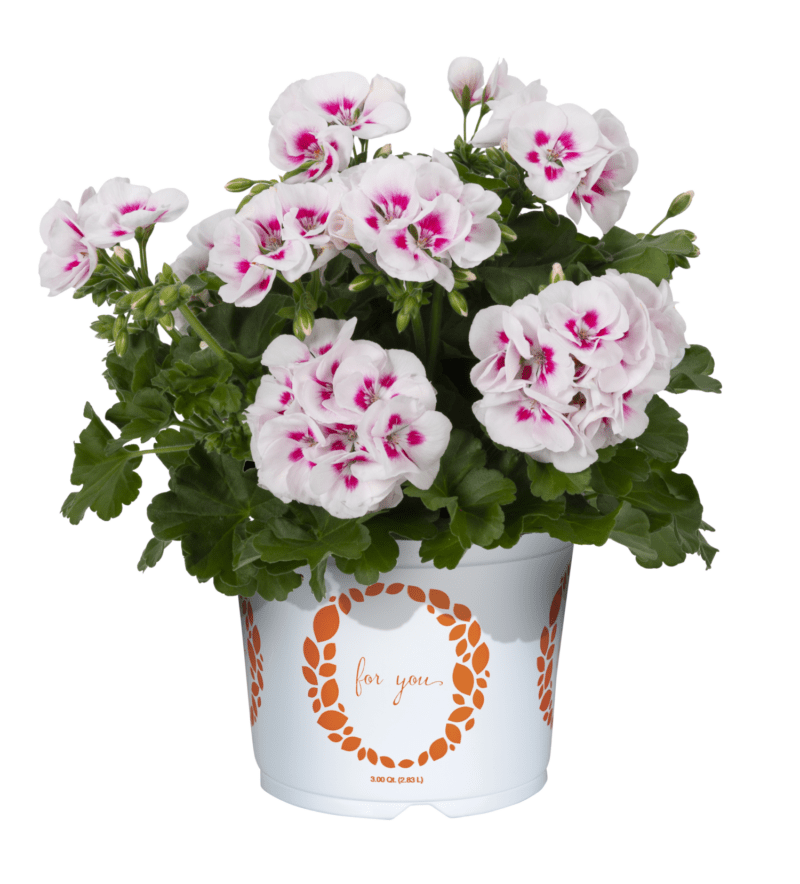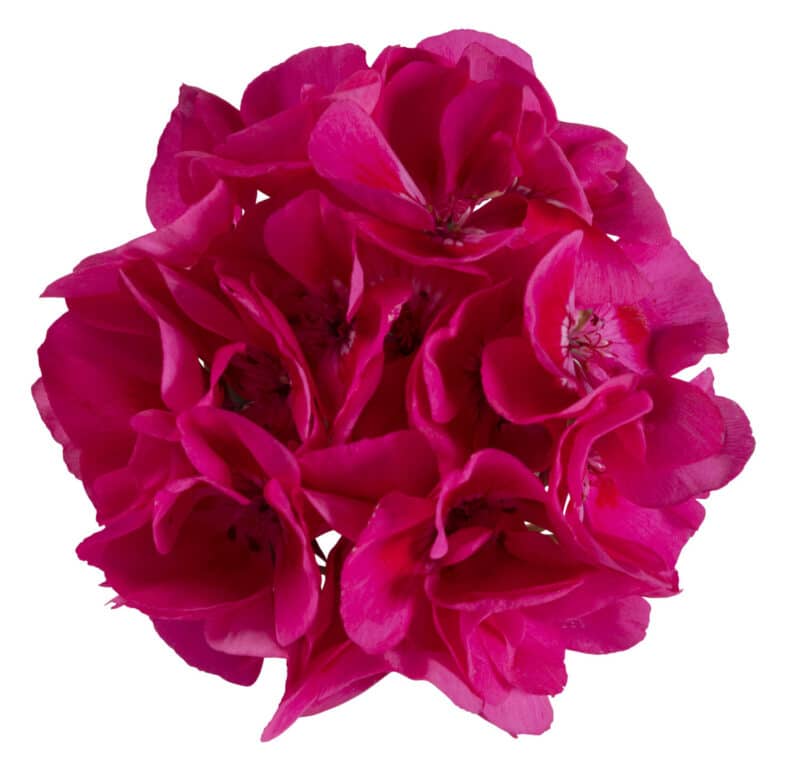
Culture Report: Santana Interspecific Geraniums
Interspecific breeding equals zonal geranium aesthetics with extra large umbels, dark green foliage, and the heat and drought tolerance of ivy geraniums. In a large class of interspecific breeding in today’s market, Santana are special, being a true grower series. All seven colors of Santana are uniform in vigor, habit, branching characteristics and flower timing.
The seven colors included are Dark Red, Fire, White, Pink, Purple, White Splash and Pink Splash. Often the white selection and splash types within a geranium series can be more compact and later to flower. Santana White, White Splash and Pink Splash were carefully selected to be a perfect match to the rest of the series. Bench running or multi-color combo pots are a breeze with the uniformity of the Santana series.
White
White Splash
PROPAGATION
Open boxes upon arrival and stick immediately — generally geraniums should be high on the sticking priority list. Cuttings can be stored in a cooler held at 40 to 45° F; relative humidity helps restore turgidity lost during shipping. Maintain relative humidity at a minimum of 70%. Rooting hormone is not necessary but used occasionally as a tool to counteract slow rooting if leaf loss is a concern after sticking.
If lower leaf yellowing and leaf loss is a concern, an overhead heavy spray of water-soluble K-IBA at 250 to 300 ppm, done 24 to 48 hours after sticking, is beneficial in accelerating rooting speed. Santana prefer moderate mist levels for the first seven to 10 days, and it is ideal to provide a mist-free environment by day 10.
Once overhead irrigation is possible, feeding can begin using 100 to 150 ppm calcium nitrate and magnesium nitrate blend. Maintain a substrate electrical conductivity (EC) of 1.0 to 1.5 mS/cm using saturated media extract (SME) and a pH of 6.0 to 6.4. Avoid excessive night temperatures, especially right after sticking, to minimize mist needs to keep the cuttings turgid. An average air temperature of 65 to 75° F and soil temperature of 72° F is optimal. Maintain light levels of 4 to 6 mols/day for the first two weeks. Once roots are active, increase the daily light integral (DLI) to 12 mols/day.
Pinching is not recommended. Santana have moderate vigor; if conditions in propagation are favorable for stretch, PGRs may be necessary. Moderate rates of Cycocel (750 to 100 ppm) or a combination of Cycocel (1,000 ppm) plus B-Nine (2,500 ppm) are generally sufficient. Florel can also be used to improve branching, eliminate premature buds and control growth. Use Florel at 300 to 350 ppm but only on healthy cuttings. Florel creates a stress reaction; do not apply it to stressed cuttings.
All seven colors of Santana root uniformly; depending on the environment Santana should root easily in three to four weeks. Direct sticking unrooted or callused cuttings in the finished container is also possible and will reduce crop timing by one to two weeks.
Fire
Pink Splash
FINISHING
Santana are best suited for 6-inch pots or gallon containers, 8- and 10-inch patio containers, or 10- and 12-inch hanging baskets. Transplant directly in the finished container and choose a well-drained, soilless media with a pH of 6.0 to 6.4. Santana have moderate fertility needs. Constant feed at 200 to 250 ppm using a fertilizer low in phosphorus and ammonium will control unwanted stretch. Using the saturated media extract, maintain the EC at 2.0 to 2.5 mS/cm.
Geraniums, including Santana, are happiest at a moisture level 3, which means keeping the media slightly moist at all times. While geraniums will tolerate an occasional dry down, repeated dry periods will have a negative impact on crop quality.
Bright light will encourage fast flowering and a DLI of 16 to 18 mols/day will produce the best quality plants. Lower light levels can delay flowering and result in weaker growth. Warm temperatures will encourage timely flowering; maintain night temperatures at 65 to 70° F and day temperatures at 70 to 75° F.
Santana have excellent branching characteristics. Florel is not necessary to enhance branching but can be used on larger containers at 350 ppm to promote strong branching. Apply Florel early. As soon as roots are active, late applications of Florel will delay flowering. PGR needs are moderate. Use Cycocel (750 to 1,000 ppm) or a combination of Cycocel (1,000 ppm) and B-Nine (2,500 ppm). Bonzi at 3 to 5 ppm is also an option in warm conditions. Consider also using Bonzi at finish to hold plants in full flower at a rate of 0.1 ppm.
Common disease concerns include botrytis and rhizoctonia. Botrytis is the most common concern, especially with close spacing and overhead irrigation. A preventative fungicide rotation combined with adequate airflow and proper spacing will prevent issues with botrytis as the canopy becomes dense at finish. Common insect pests include thrips, aphids, and fungus gnats, which can all be easily controlled as part of standard preventative chemical and biological programs.
SCHEDULING
Scheduling will vary depending on growing conditions and container sizes. Expected production times for Santana from transplant are shown in Table 1.
Production of high-quality interspecific geraniums has never been easier with Santana. Uniformity equals production ease and grower success!
For an enhanced reading experience, view this article in our digital edition by clicking here.






 Video Library
Video Library 




















